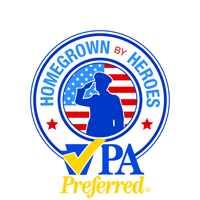The Weblog

This page contains news, event information, and other items added by the market managers.
Why Lard???
Freshly Made Lard Processed This Week
Green"er" Acres Farm made two huge batches of their own home processed lard this weekend (approximately 100 pounds of beautiful pure white lard.) Our lard is not hydrogenated like some brands seen at your local grocery store.
So why use lard? Isn’t it unhealthy? My doctor would freak out!
We hear this quite frequently as the asking person is turning their nose up. Home processed lard is actually making a come back in favor of many health professionals.
In recent generations, lard has seemed to completely disappear from home kitchens. Until the early 1900’s, lard was a staple cooking fat across the globe. It was the secret to perfectly flaky pie pastry, crispy fried chicken, melt-in-your-mouth biscuits and luscious gravy.
Now, when people hear the term lard, they immediately conjure up a vision of clogged arteries. It’s time to set the record straight – lard is a healthy cooking fat and deserves to make a comeback in kitchens everywhere.
According to a recent article found on the Prevention Magazine website (https://www.prevention.com/food/should-you-be-eating-lard,) Recently, lard has come back into fashion and become a fat of choice for many nutritionists, Paleo dieters, and hordes of famous chefs, including the Food Network’s Alton Brown, who proclaimed lard to be the best cooking fat ever.
Isn’t lard full of the saturated fat that doctors warn can clog up your arteries?
Well, not really. Saturated fat makes up only about 40% of the fat in lard and actually isn’t as bad for your health as doctors used to think. In fact, many experts now argue that eating saturated fat is good for overall health. Recent studies have found that eating more saturated fat doesn’t increase the risk of heart disease at all, while some studies show it can raise good HDL cholesterol and lower the risk of heart disease when combined with a low-carb or low-sugar diet.
Besides, lard is lower in saturated fat than other animal fats like butter and tallow, and higher in heart-healthy monounsaturated fat—the type that gives olive oil its health halo. Lard is made up of 50% monounsaturated fat—compare that to only 32% in butter and 6% in coconut oil. Plus, in its natural form, lard has none of the trans fats that we know are bad for you.
Also, according to information found at the Empowered Sustenance website (https://empoweredsustenance.com/lard-is-healthy/), 1) An analysis of more than 300,000 people published in the American Journal of Clinical Nutrition shows that there is no evidence that saturated fat consumption raises the risk of heart disease, 2) A low fat diet has been shown to increase triglycerides, which is a risk factor for heart disease, 3) The director of the large Framingham Heart Study concluded, “We found that the people who ate the most cholesterol, ate the most saturated fat, ate the most calories, weighed the least and were the most physically active.”, 4) Saturated fat intake raises HDL cholesterol, which is associated with a reduced risk of heart disease, and 5) The “diseases of modern civilization” including heart disease and diabetes skyrocketed as animal fats were replaced with factory fats including vegetable oils and margarine.
Using lard in cooking
Because lard contains more saturated fat than veggie oils, it doesn’t go rancid as quickly and has a higher smoke point, making it better for frying and high-heat cooking. “The chemical makeup of saturated fats is very stable,” Nichols says. “Unsaturated fats like those found in vegetable oils, on the other hand, tend to go bad and change structure the longer they cook.” This means oils like canola, corn, or olive cooked at a high heat or used repeatedly (like in restaurant fry cookers) can start to break down and release free radicals, which then lead to inflammation.
If that’s not enough to convince you, lard also just makes things taste better—there’s a reason your grandma used it in everything from pies to scrambled eggs. Due to the neutral flavor, it also works exceptionally well in baked goods.
So why buy lard from my local farmers?
First, most brands of lard sold in your local grocery or “big box” stores is hydrogenated. Hydrogenation, complete or partial, is a chemical process in which hydrogen is added to liquid oils to turn them into a solid form. Partially hydrogenated fat molecules have trans fats, and they may be the worst type of fat you can consume.
The lard produced by Green"er" Acres Farm is made from the hogs that we raise for our own consumption and to make the whole hog sausage that we sell once a year. Our hogs are treated well and killed in a humane manner. We then boil the lard on-site, rendering and pressing it though lard press that has been used for generations on the farm and filtered through cheesecloth, We then freeze the blocks of solid lard (it naturally hardens from a liquid state when left to sit at room temperature) in vacuum-sealed bags. This allows the lard to be kept for up to 3 years without going rancid. You can then simply remove it from the freezer, cup off what you need to keep on the counter in a jar, and return the rest to the freezer for longer keeping.
Try some lard today!
We offer our lard in several sizes. Try some today. We are so confident that you will find it a superior cooking oil that we offer you a money back guarantee. If, for any reason, you are not happy with Green"er" Acres Farm’s home processed lard, simply return the unused portion, and we will issue a refund of the entire purchase price.

